2009 CHEVROLET CORVETTE check oil
[x] Cancel search: check oilPage 293 of 434

Notice:Do not add too much oil. If the engine
has so much oil that the oil level gets above the
cross-hatched area that shows the proper operating
range, the engine could be damaged.
SeeEngine Compartment
Overview on page 5-14
for the location of the
engine oil �ll cap.
Add enough oil to put the level somewhere in the proper
operating range. Push the dipstick all the way back in
when you are through.Checking Engine Oil (ZO6 and ZR1)
A. Engine Oil Dipstick
B. Engine Oil Fill Cap
It is a good idea to check the engine oil level every time
you get fuel. In order to get an accurate reading, the oil
must be warm and the vehicle must be on level ground.
5-21
Page 294 of 434
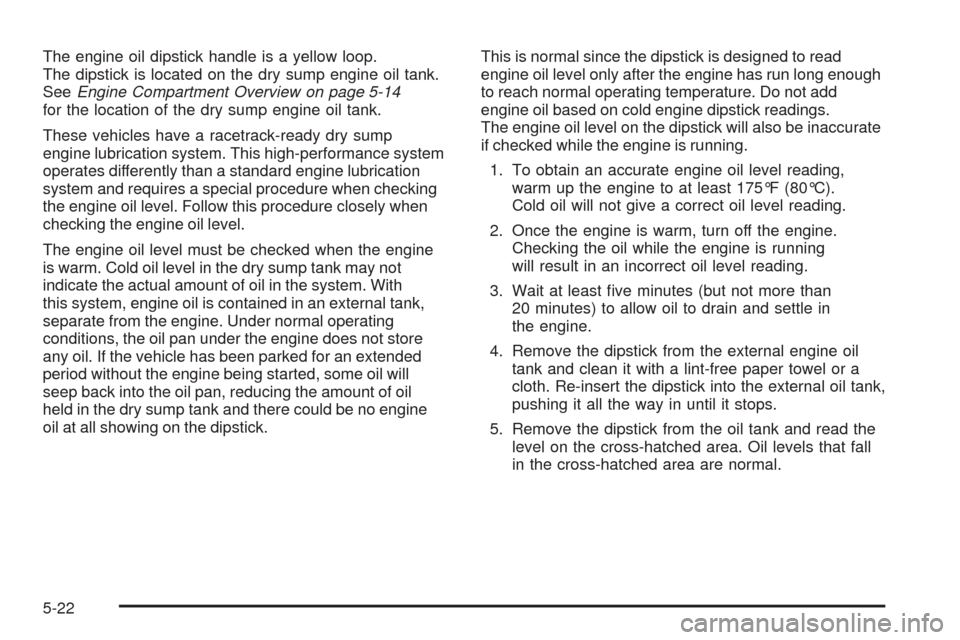
The engine oil dipstick handle is a yellow loop.
The dipstick is located on the dry sump engine oil tank.
SeeEngine Compartment Overview on page 5-14
for the location of the dry sump engine oil tank.
These vehicles have a racetrack-ready dry sump
engine lubrication system. This high-performance system
operates differently than a standard engine lubrication
system and requires a special procedure when checking
the engine oil level. Follow this procedure closely when
checking the engine oil level.
The engine oil level must be checked when the engine
is warm. Cold oil level in the dry sump tank may not
indicate the actual amount of oil in the system. With
this system, engine oil is contained in an external tank,
separate from the engine. Under normal operating
conditions, the oil pan under the engine does not store
any oil. If the vehicle has been parked for an extended
period without the engine being started, some oil will
seep back into the oil pan, reducing the amount of oil
held in the dry sump tank and there could be no engine
oil at all showing on the dipstick.This is normal since the dipstick is designed to read
engine oil level only after the engine has run long enough
to reach normal operating temperature. Do not add
engine oil based on cold engine dipstick readings.
The engine oil level on the dipstick will also be inaccurate
if checked while the engine is running.
1. To obtain an accurate engine oil level reading,
warm up the engine to at least 175°F (80°C).
Cold oil will not give a correct oil level reading.
2. Once the engine is warm, turn off the engine.
Checking the oil while the engine is running
will result in an incorrect oil level reading.
3. Wait at least �ve minutes (but not more than
20 minutes) to allow oil to drain and settle in
the engine.
4. Remove the dipstick from the external engine oil
tank and clean it with a lint-free paper towel or a
cloth. Re-insert the dipstick into the external oil tank,
pushing it all the way in until it stops.
5. Remove the dipstick from the oil tank and read the
level on the cross-hatched area. Oil levels that fall
in the cross-hatched area are normal.
5-22
Page 296 of 434
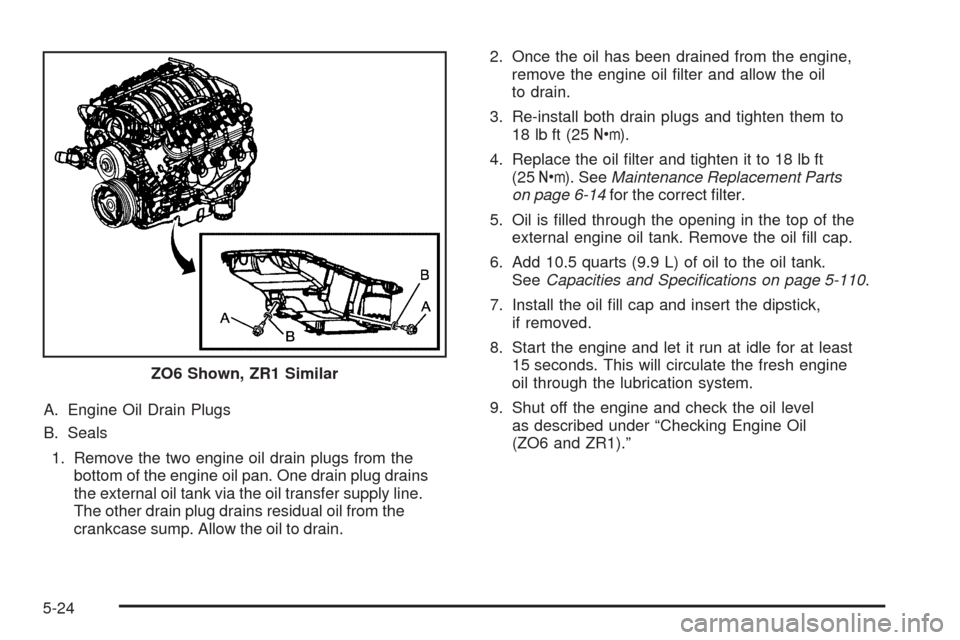
A. Engine Oil Drain Plugs
B. Seals
1. Remove the two engine oil drain plugs from the
bottom of the engine oil pan. One drain plug drains
the external oil tank via the oil transfer supply line.
The other drain plug drains residual oil from the
crankcase sump. Allow the oil to drain.2. Once the oil has been drained from the engine,
remove the engine oil �lter and allow the oil
to drain.
3. Re-install both drain plugs and tighten them to
18 lb ft (25Y).
4. Replace the oil �lter and tighten it to 18 lb ft
(25Y). SeeMaintenance Replacement Parts
on page 6-14for the correct �lter.
5. Oil is �lled through the opening in the top of the
external engine oil tank. Remove the oil �ll cap.
6. Add 10.5 quarts (9.9 L) of oil to the oil tank.
SeeCapacities and Specifications on page 5-110.
7. Install the oil �ll cap and insert the dipstick,
if removed.
8. Start the engine and let it run at idle for at least
15 seconds. This will circulate the fresh engine
oil through the lubrication system.
9. Shut off the engine and check the oil level
as described under “Checking Engine Oil
(ZO6 and ZR1).” ZO6 Shown, ZR1 Similar
5-24
Page 298 of 434
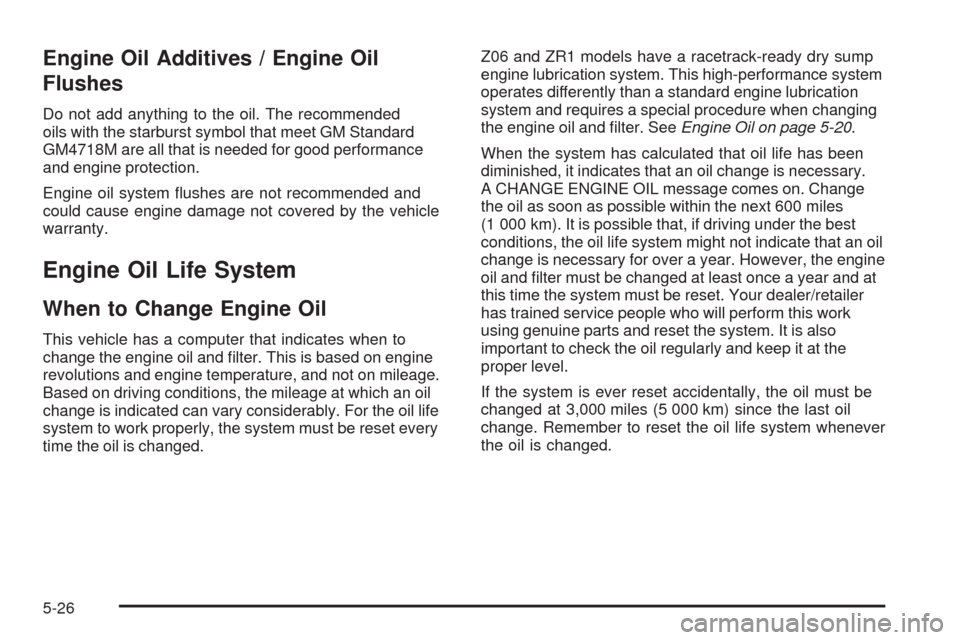
Engine Oil Additives / Engine Oil
Flushes
Do not add anything to the oil. The recommended
oils with the starburst symbol that meet GM Standard
GM4718M are all that is needed for good performance
and engine protection.
Engine oil system �ushes are not recommended and
could cause engine damage not covered by the vehicle
warranty.
Engine Oil Life System
When to Change Engine Oil
This vehicle has a computer that indicates when to
change the engine oil and �lter. This is based on engine
revolutions and engine temperature, and not on mileage.
Based on driving conditions, the mileage at which an oil
change is indicated can vary considerably. For the oil life
system to work properly, the system must be reset every
time the oil is changed.Z06 and ZR1 models have a racetrack-ready dry sump
engine lubrication system. This high-performance system
operates differently than a standard engine lubrication
system and requires a special procedure when changing
the engine oil and �lter. SeeEngine Oil on page 5-20.
When the system has calculated that oil life has been
diminished, it indicates that an oil change is necessary.
A CHANGE ENGINE OIL message comes on. Change
the oil as soon as possible within the next 600 miles
(1 000 km). It is possible that, if driving under the best
conditions, the oil life system might not indicate that an oil
change is necessary for over a year. However, the engine
oil and �lter must be changed at least once a year and at
this time the system must be reset. Your dealer/retailer
has trained service people who will perform this work
using genuine parts and reset the system. It is also
important to check the oil regularly and keep it at the
proper level.
If the system is ever reset accidentally, the oil must be
changed at 3,000 miles (5 000 km) since the last oil
change. Remember to reset the oil life system whenever
the oil is changed.
5-26
Page 308 of 434
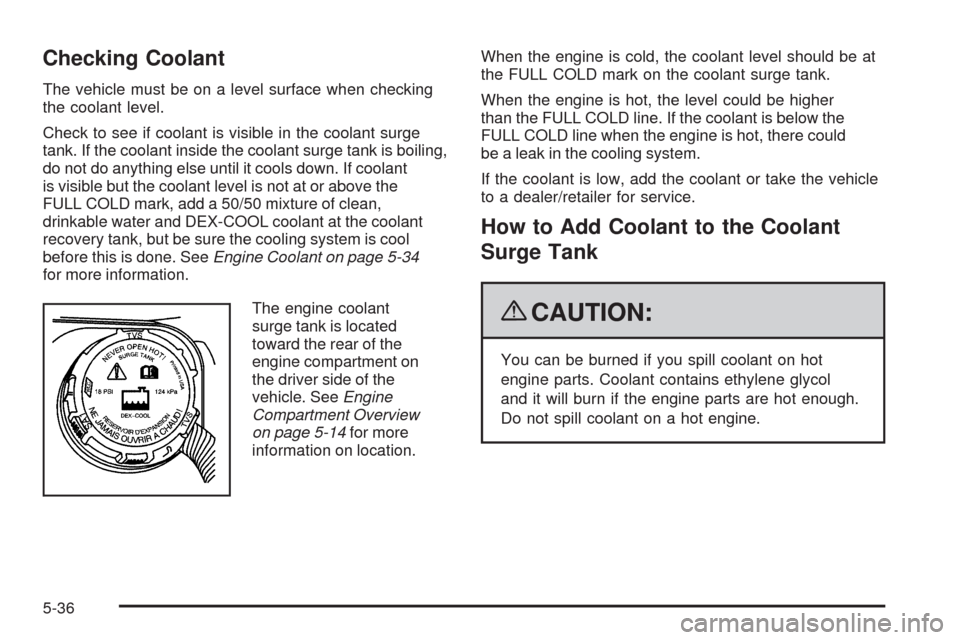
Checking Coolant
The vehicle must be on a level surface when checking
the coolant level.
Check to see if coolant is visible in the coolant surge
tank. If the coolant inside the coolant surge tank is boiling,
do not do anything else until it cools down. If coolant
is visible but the coolant level is not at or above the
FULL COLD mark, add a 50/50 mixture of clean,
drinkable water and DEX-COOL coolant at the coolant
recovery tank, but be sure the cooling system is cool
before this is done. SeeEngine Coolant on page 5-34
for more information.
The engine coolant
surge tank is located
toward the rear of the
engine compartment on
the driver side of the
vehicle. SeeEngine
Compartment Overview
on page 5-14for more
information on location.When the engine is cold, the coolant level should be at
the FULL COLD mark on the coolant surge tank.
When the engine is hot, the level could be higher
than the FULL COLD line. If the coolant is below the
FULL COLD line when the engine is hot, there could
be a leak in the cooling system.
If the coolant is low, add the coolant or take the vehicle
to a dealer/retailer for service.
How to Add Coolant to the Coolant
Surge Tank
{CAUTION:
You can be burned if you spill coolant on hot
engine parts. Coolant contains ethylene glycol
and it will burn if the engine parts are hot enough.
Do not spill coolant on a hot engine.
5-36
Page 313 of 434
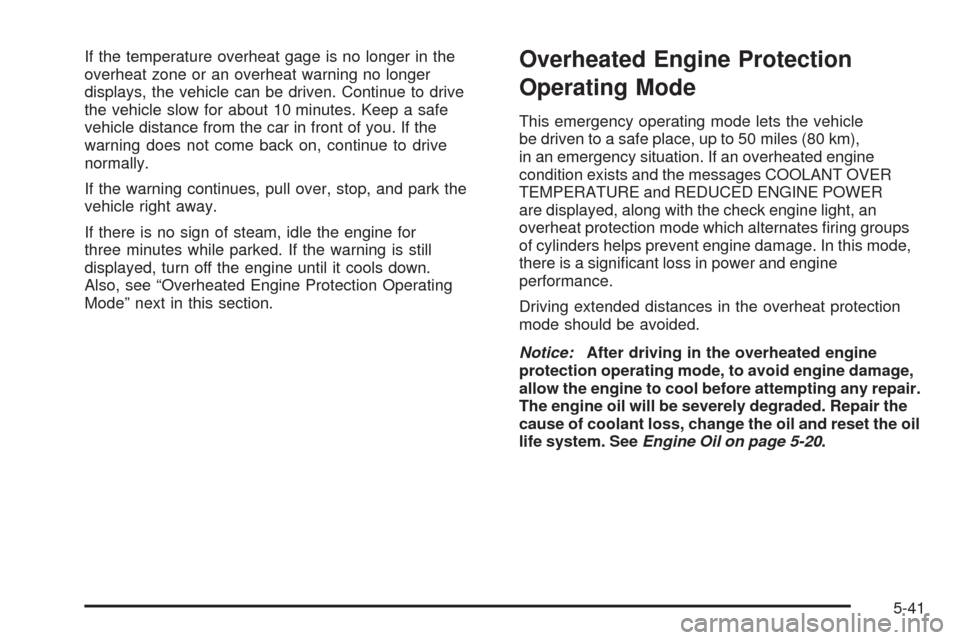
If the temperature overheat gage is no longer in the
overheat zone or an overheat warning no longer
displays, the vehicle can be driven. Continue to drive
the vehicle slow for about 10 minutes. Keep a safe
vehicle distance from the car in front of you. If the
warning does not come back on, continue to drive
normally.
If the warning continues, pull over, stop, and park the
vehicle right away.
If there is no sign of steam, idle the engine for
three minutes while parked. If the warning is still
displayed, turn off the engine until it cools down.
Also, see “Overheated Engine Protection Operating
Mode” next in this section.Overheated Engine Protection
Operating Mode
This emergency operating mode lets the vehicle
be driven to a safe place, up to 50 miles (80 km),
in an emergency situation. If an overheated engine
condition exists and the messages COOLANT OVER
TEMPERATURE and REDUCED ENGINE POWER
are displayed, along with the check engine light, an
overheat protection mode which alternates �ring groups
of cylinders helps prevent engine damage. In this mode,
there is a signi�cant loss in power and engine
performance.
Driving extended distances in the overheat protection
mode should be avoided.
Notice:After driving in the overheated engine
protection operating mode, to avoid engine damage,
allow the engine to cool before attempting any repair.
The engine oil will be severely degraded. Repair the
cause of coolant loss, change the oil and reset the oil
life system. SeeEngine Oil on page 5-20.
5-41
Page 317 of 434

Checking Brake Fluid
Check brake �uid by looking at the brake �uid reservoir.
SeeEngine Compartment Overview on page 5-14.
The �uid level should be above the MIN mark on the
reservoir. If it is not, have the brake hydraulic system
checked to see if there is a leak.
After work is done on the brake hydraulic system, make
sure the level is between the MIN and MAX marks.
What to Add
Use only new DOT-3 brake �uid from a sealed
container. SeeRecommended Fluids and Lubricants
on page 6-12.
Always clean the brake �uid reservoir cap and the area
around the cap before removing it. This helps keep
dirt from entering the reservoir.
{CAUTION:
With the wrong kind of �uid in the brake hydraulic
system, the brakes might not work well. This could
cause a crash. Always use the proper brake �uid.
Notice:
Using the wrong �uid can badly damage brake
hydraulic system parts. For example, just a few
drops of mineral-based oil, such as engine oil, in
the brake hydraulic system can damage brake
hydraulic system parts so badly that they will
have to be replaced. Do not let someone put in
the wrong kind of �uid.
If brake �uid is spilled on the vehicle’s painted
surfaces, the paint �nish can be damaged.
Be careful not to spill brake �uid on the vehicle.
If you do, wash it off immediately. SeeWashing
Your Vehicle on page 5-95.
5-45
Page 386 of 434
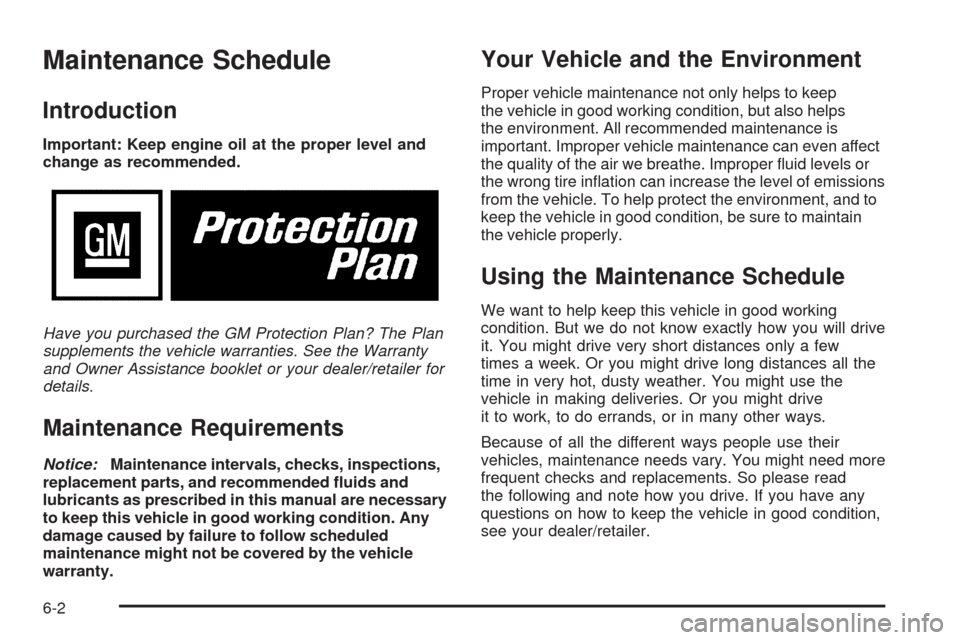
Maintenance Schedule
Introduction
Important: Keep engine oil at the proper level and
change as recommended.
Have you purchased the GM Protection Plan? The Plan
supplements the vehicle warranties. See the Warranty
and Owner Assistance booklet or your dealer/retailer for
details.
Maintenance Requirements
Notice:Maintenance intervals, checks, inspections,
replacement parts, and recommended �uids and
lubricants as prescribed in this manual are necessary
to keep this vehicle in good working condition. Any
damage caused by failure to follow scheduled
maintenance might not be covered by the vehicle
warranty.
Your Vehicle and the Environment
Proper vehicle maintenance not only helps to keep
the vehicle in good working condition, but also helps
the environment. All recommended maintenance is
important. Improper vehicle maintenance can even affect
the quality of the air we breathe. Improper �uid levels or
the wrong tire in�ation can increase the level of emissions
from the vehicle. To help protect the environment, and to
keep the vehicle in good condition, be sure to maintain
the vehicle properly.
Using the Maintenance Schedule
We want to help keep this vehicle in good working
condition. But we do not know exactly how you will drive
it. You might drive very short distances only a few
times a week. Or you might drive long distances all the
time in very hot, dusty weather. You might use the
vehicle in making deliveries. Or you might drive
it to work, to do errands, or in many other ways.
Because of all the different ways people use their
vehicles, maintenance needs vary. You might need more
frequent checks and replacements. So please read
the following and note how you drive. If you have any
questions on how to keep the vehicle in good condition,
see your dealer/retailer.
6-2